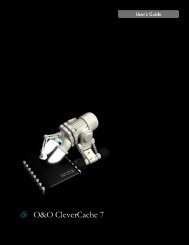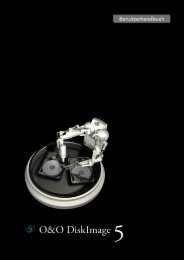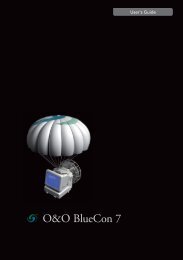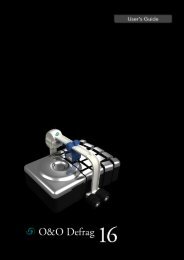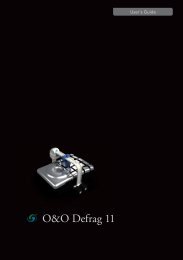O&O DiskImage 7 User's Guide - O&O Software
O&O DiskImage 7 User's Guide - O&O Software
O&O DiskImage 7 User's Guide - O&O Software
Create successful ePaper yourself
Turn your PDF publications into a flip-book with our unique Google optimized e-Paper software.
Quick Start<br />
1. Please make sure that the drive containing the base image is connected to your computer.<br />
2. Start O&O <strong>DiskImage</strong> and select Drive imaging on the start page.<br />
3. Enable the check for Incremental imaging.<br />
4. Select your base image in the browser window and click Open.<br />
5. Now click Apply (if you want to specify further settings) or on OK to proceed with the imaging.<br />
6. Click Start drive imaging.<br />
7. Now you can either select the recommended target folder for saving the image, or enter a new target path. For<br />
the sake of clarity, we recommend saving the base image and any subsequent images in one folder. The image<br />
is automatically named after the creation date. You can however enter a name manually.<br />
8. Click Start, to initiate the imaging process.<br />
Note:When creating an image of the changes, O&O <strong>DiskImage</strong> compares each sector of the existing image with<br />
the corresponding sector of the (source) disk being imaged. This might require more time than a complete image.<br />
The image of the changes, however, takes up much less space than a complete image.<br />
Note: The option Compare data with checksums is set by default. The last incremental image is all you'll need as<br />
a base image for creating a new incremental image.Use checksums to administer unchanged<br />
data is not set, you will need the last base image and all the incremental images previously created, because all of<br />
them must be accessed for creating the new image.<br />
Backup changes in a file<br />
A complete image or a previously created image of the changes can be used as base image.<br />
Follow the instructions below:<br />
1. Please make sure that the drive containing the base image is connected to your computer.<br />
2. Start O&O <strong>DiskImage</strong> and select File backup on the start page.<br />
3. Enable the check for Incremental File backup.<br />
4. Select your base image in the browser window and click Open.<br />
5. Now click Apply (if you want to specify further settings) or OK to proceed with the imaging.<br />
6. Click Start file backup.<br />
7. Now you can either select the recommended target folder for saving the image or enter a new target path. For<br />
the sake of clarity, we recommend saving the base image and its subsequent images in one folder. The image is<br />
automatically named after the creation date. You can however enter a name manually.<br />
8. Click Start, to initiate the imaging process.<br />
Clone drives<br />
Entire storage volumes or individual drives can be cloned, which in turn can be used instead of the originals. This function<br />
allows you to clone a drive and all its saved data without creating image files. The source disks/drives will be reproduced<br />
without any changes.<br />
Please keep in mind that a clone requires much more free space than an image.<br />
Unlike images, there are no incremental or differential clones possible for reducing the data volume of successive<br />
"Clone drives"clones. In addition, a clone cannot be compressed or encrypted compared to an image.<br />
1. Select Clone drive in the Quickaccess bar.<br />
2. Select the drive which you want to clone by enabling the check next to each drive or the entire disk.<br />
3. You can set additional settings for cloning under Cloning options.<br />
O&O <strong>DiskImage</strong>-27



